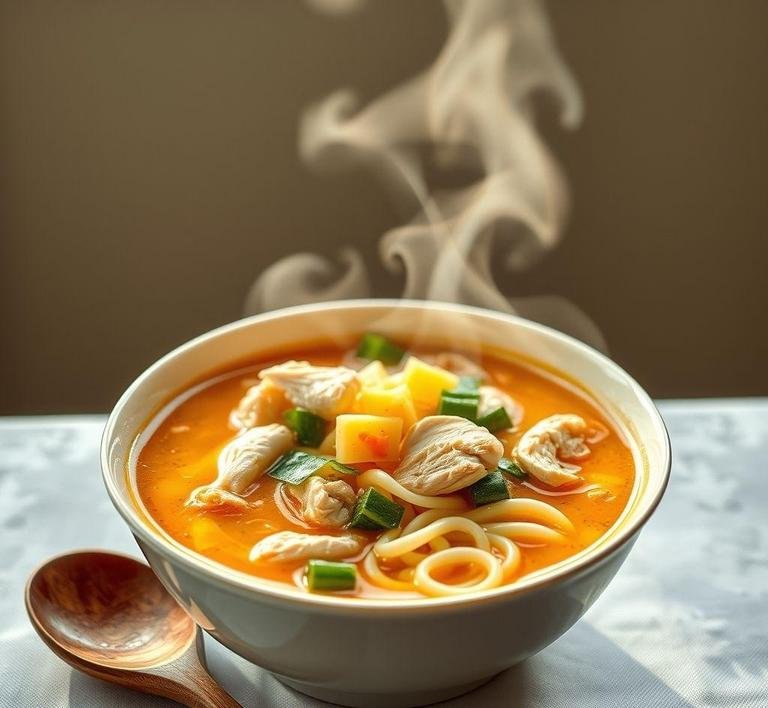Mary Berry’s Chicken Noodle Soup is a comforting, flavorful, and wholesome dish that brings together the simplicity of chicken, vegetables, and noodles with a rich, savory broth. A beloved recipe by the iconic British chef, Mary Berry, this soup embodies everything that makes a great homemade meal: hearty, nourishing, and easy to prepare. It’s the type of meal you’d want to sip slowly on a chilly day, as it gently warms you from the inside out.
The beauty of this chicken noodle soup lies in its balance between lightness and richness. The clear broth is made from a delicious chicken stock that’s both aromatic and savory, while the chicken itself is tender and juicy, adding substance to the soup. The addition of vegetables like carrots, onions, and celery enhances the flavor and texture, giving the soup a wholesome and colorful depth. Meanwhile, the noodles bring a comforting, filling element to the dish, making it a complete meal in a bowl.
What makes this particular chicken noodle soup stand out is Mary Berry’s unique approach to making the most of fresh ingredients while simplifying the cooking process, ensuring that anyone can make it with ease, whether they’re an experienced chef or just a novice in the kitchen. This dish is perfect for family gatherings, a cozy dinner, or when you’re feeling under the weather and need something soothing and nutritious.
Mary Berry’s Chicken Noodle Soup Recipe
Ingredients Needed

The ingredients for Mary Berry’s Chicken Noodle Soup are straightforward but crucial for achieving the right balance of flavors. Here’s a detailed list:
- Chicken: You can use boneless, skinless chicken breasts or thighs, or a whole chicken if you prefer making your own stock. Chicken thighs are often preferred because they tend to remain tender and flavorful, while breasts are leaner.
- Noodles: Egg noodles are the most traditional choice for this soup, offering a slight chewiness that pairs well with the tender chicken and vegetables. However, if you’re looking for a gluten-free option, rice noodles work well too.
- Carrots: Fresh carrots, sliced thinly, add both a natural sweetness and a bright color to the soup, enhancing its visual appeal and nutritional value.
- Celery: Celery is a classic soup ingredient, adding a subtle crunch and mild earthy flavor that complements the other vegetables.
- Onions: A medium onion, finely chopped, gives the soup its aromatic base, infusing the broth with a rich fragrance as it simmers.
- Garlic: A couple of cloves of garlic are added for their robust flavor, which pairs beautifully with the chicken and adds depth to the broth.
- Chicken Stock: High-quality chicken stock is essential for creating the foundation of the soup. You can either use homemade stock or store-bought, but be sure it’s well-seasoned to avoid blandness.
- Herbs: Fresh herbs like parsley, thyme, or bay leaves are used to infuse the soup with a comforting, earthy fragrance. A little bit of dried oregano or rosemary could be added for extra flavor.
- Salt and Pepper: Seasoning is key to bringing the soup together. A pinch of salt and freshly ground black pepper to taste are all you need to elevate the flavors.
- Olive Oil: For sautéing the vegetables at the beginning of the recipe, a splash of olive oil helps soften them and releases their natural flavors into the broth.
Equipment Needed
To make Mary Berry’s Chicken Noodle Soup, you don’t need anything too fancy in terms of equipment. Here’s a quick rundown of what you’ll need:
- Large Soup Pot: A heavy-bottomed pot, preferably 4-5 liters in size, is ideal for this recipe. It should be large enough to hold all the ingredients and allow the soup to simmer without boiling over.
- Cutting Board & Knife: A sharp chef’s knife and a sturdy cutting board will help you chop the vegetables and chicken with ease.
- Measuring Cups & Spoons: For accuracy in measuring out ingredients like herbs, oil, and salt, these will ensure you don’t go overboard with seasonings.
- Ladle: To serve the soup, a ladle is a convenient tool for portioning out bowls without making a mess.
- Wooden Spoon or Spatula: A wooden spoon is perfect for stirring the soup and preventing it from sticking to the bottom of the pot during the cooking process.
- Colander: If you’re using fresh noodles, you’ll need a colander to drain the noodles before adding them to the soup.
- Tongs (optional): If you’re using a whole chicken or large pieces of chicken that need to be shredded, tongs will help make this task easier once they are cooked and tender.
Instructions To Make Mary Berry’s Chicken Noodle Soup
- Prepare the Chicken: If you’re using a whole chicken, begin by placing it in the pot with water, bringing it to a boil, and simmering for about 1 to 1.5 hours to create a flavorful stock. If using chicken breasts or thighs, simply dice or shred the meat into bite-sized pieces after it’s cooked through.
- Sauté the Vegetables: Heat the olive oil in a large soup pot over medium heat. Add the chopped onion, carrots, and celery, sautéing for about 5-7 minutes until softened. Stir in the minced garlic and cook for another minute until fragrant.
- Add the Stock: Pour in the chicken stock, ensuring that it covers the vegetables. If you’re using pre-cooked chicken stock, add enough to make a rich, full-flavored broth. Bring it to a simmer.
- Simmer the Soup: Once the stock begins to simmer, lower the heat and let it gently cook for about 20 minutes to allow the flavors to meld together.
- Add the Chicken and Noodles: Stir in the cooked or shredded chicken and the noodles. If you’re using egg noodles, they will only need to cook for 8-10 minutes, or until tender. If you’re using rice noodles, add them in the final few minutes to avoid overcooking.
- Season the Soup: Taste the broth and adjust the seasoning by adding salt, pepper, and any herbs like thyme or parsley. If you have bay leaves, you can throw one or two in for added depth.
- Serve: Once the noodles are cooked and the soup is perfectly seasoned, ladle it into bowls and garnish with freshly chopped parsley or additional herbs of your choice.
Tips And Tricks
- Use Homemade Stock: If you have the time, make your own chicken stock for an extra boost of flavor. It’ll be richer and more aromatic, adding depth to the soup.
- Don’t Overcook the Noodles: Noodles can easily become mushy in soup, so be sure to keep an eye on the cooking time. If you’re prepping the soup ahead of time, consider cooking the noodles separately and adding them just before serving.
- Shred the Chicken: For a more traditional feel, shred the cooked chicken instead of just chopping it. The shredded meat will absorb the flavors of the broth more easily and feel more like a ‘classic’ chicken noodle soup.
- Add Greens: For an extra nutritional boost, consider adding spinach, kale, or other leafy greens toward the end of cooking. They wilt quickly and complement the soup’s flavors.
- Make it Spicy: If you like a little heat, throw in some red pepper flakes or a diced chili to give the soup a mild kick.
- Use Leftover Chicken: This recipe is perfect for repurposing leftover roast chicken. Just shred the meat and add it to the broth for a quicker version of the soup.
Easy Recipe Variations For Mary Berry’s Chicken Noodle Soup

Mary Berry’s Chicken Noodle Soup is a beloved, comforting classic, known for its simplicity and the perfect balance of flavors. But there’s always room for creativity! If you’re looking to elevate the dish or add a unique twist, there are countless ways to tweak the recipe to suit your tastes or dietary needs.
-
Add a Spicy Kick:
If you’re a fan of bold flavors, why not spice up your chicken noodle soup? Add a dash of chili flakes or cayenne pepper to give it a subtle heat. Alternatively, finely chop some fresh red chili peppers or add a spoonful of sriracha or harissa for a more intense flavor. These ingredients complement the savory chicken broth beautifully.
-
Boost the Veggies:
For those wanting more vegetables in their soup, Mary Berry’s recipe can easily be adapted. You can toss in some extra carrots, celery, or onions, or experiment with spinach, kale, or peas. These not only enhance the nutritional value but also add texture and vibrant color to the soup. For a more robust, earthy flavor, try incorporating sweet potatoes, which add a soft, creamy element to the broth.
-
Different Noodles for Variety:
While traditional egg noodles are Mary’s go-to choice, you can switch it up by using rice noodles for a lighter version, or whole wheat noodles for added fiber. For a more decadent variation, try udon noodles for their thick, chewy texture or even zucchini noodles (zoodles) for a low-carb alternative.
-
Herb Variations:
While thyme and parsley are classic herbs in this soup, you can introduce different flavor profiles with various herbs. Basil and oregano work wonderfully if you’re leaning toward a more Mediterranean vibe. For something more fragrant, lemon thyme or tarragon could infuse the broth with a refreshing citrusy flavor.
-
Creamy Version:
If you prefer a creamier, more indulgent soup, you can add a generous swirl of double cream or coconut milk just before serving. This would transform the broth into a rich, velvety texture that adds a touch of luxury. If you’re dairy-free, coconut milk also brings a lovely, slightly sweet undertone.
-
Add Protein Punch:
While chicken is the star of Mary’s soup, there’s no harm in experimenting with other proteins. Consider adding shredded rotisserie chicken for a faster alternative or even turkey for a post-Thanksgiving twist. For those seeking a plant-based protein, tofu or chickpeas are great substitutes that soak up the delicious broth.
-
Flavorful Broths:
A great way to customize your soup is to change the base broth itself. Instead of just a standard chicken stock, you can try a vegetable broth for a lighter, vegetarian option, or a miso broth for a deep, umami-rich soup. For a more intense chicken flavor, you can opt for homemade stock or even bone broth, which is known for its rich, nutritious qualities.
Storing Leftovers
Mary Berry’s Chicken Noodle Soup is not only delicious the day it’s made, but it also makes for fantastic leftovers! With just a few simple steps, you can extend the life of this hearty dish, ensuring it stays as flavorful as the first bowl.
-
Refrigeration:
If you’re planning to enjoy your leftovers within a few days, storing the soup in the refrigerator is your best bet. First, let the soup cool to room temperature, as putting hot food directly in the fridge can affect the texture and flavor. Transfer the soup into an airtight container and store it in the fridge for 3 to 4 days.
However, because the noodles can absorb a lot of the broth over time and become mushy, you might want to store the noodles separately. This way, they remain firm when you reheat the soup.
-
Freezing Leftovers:
For longer-term storage, freezing your soup is an excellent option. However, similar to refrigeration, you should freeze the soup and noodles separately to prevent the noodles from becoming too soggy when thawed. You can freeze the soup base in an airtight container or heavy-duty freezer bag for up to 3 months. When you’re ready to enjoy it again, simply thaw the soup in the fridge overnight and reheat it on the stovetop.
For best results, reheat slowly on low to medium heat, stirring occasionally. You may want to add a bit more liquid (chicken stock or water) as the soup may thicken during freezing.
-
Reheating Tips:
When reheating the soup, it’s always a good idea to taste it and adjust the seasoning if needed. Sometimes, freezing or refrigeration can mute the flavors, so a pinch of salt, pepper, or fresh herbs like parsley or thyme can bring back that freshly-made taste. If you stored the noodles separately, simply cook them fresh or add them in during the last few minutes of reheating to prevent them from getting too soft.
What To Eat With Mary Berry’s Chicken Noodle Soup?
Chicken noodle soup is a versatile dish that pairs well with many sides, whether you want something light and refreshing or hearty and indulgent. Here are some delightful options to complement this cozy meal:
-
Crusty Bread or Rolls:
No soup is complete without some warm, fresh bread. A rustic sourdough or ciabatta loaf is perfect for soaking up the rich broth. If you’re feeling extra indulgent, opt for buttery garlic bread or cheese-stuffed bread rolls to add extra flavor to the meal. These options give a satisfying contrast to the smooth, savory soup.
-
Salads:
A light, crisp salad offers a refreshing contrast to the warmth of the soup. Try a mixed greens salad with a tangy vinaigrette, or a cucumber and tomato salad with a squeeze of lemon and a sprinkle of herbs for freshness. For a heartier option, a Greek salad with olives, feta, and red onions pairs wonderfully with the chicken noodle soup, providing additional layers of texture and flavor.
-
Pickles or Fermented Vegetables:
Adding something tangy and crunchy, such as pickled cucumbers, sauerkraut, or kimchi, can elevate the soup experience. The acidity and crunch of these sides balance out the richness of the broth, creating a delightful contrast.
-
Cheese and Crackers:
If you’re looking for something easy and crowd-pleasing, a platter of cheese and crackers can complement the soup. Think sharp cheddar, creamy brie, or crumbly goat cheese, paired with a selection of crunchy crackers. This side option works especially well if you’re serving the soup as part of a larger meal or sharing it at a gathering.
-
Roasted Vegetables:
Roasting seasonal vegetables like carrots, parsnips, or brussels sprouts adds a smoky, caramelized flavor that pairs wonderfully with the savory broth. These vegetables provide a satisfying balance of sweetness and depth to round out the meal.
Conclusion
Mary Berry’s Chicken Noodle Soup is the epitome of comfort food, with its heartwarming flavors and versatile ingredients. Whether you stick to the classic recipe or experiment with new twists, this dish remains a family favorite for its ease and nourishing qualities. The variations you can make, from spicing it up with chili to adding more veggies or trying a creamy version, ensure that there’s something for every palate.
Leftovers are just as delightful, and knowing how to store and reheat them properly ensures that nothing goes to waste. And when it comes to pairing, the possibilities are endless-from crusty bread to tangy salads and even pickles-these sides only enhance the soup’s comforting nature.
At its core, this soup is about warmth, simplicity, and the joy of sharing a meal with loved ones. Whether you’re enjoying it on a chilly evening, during a busy workweek, or when you’re in need of some self-care, Mary Berry’s Chicken Noodle Soup is sure to be a dish that brings a smile to your face. So, grab a bowl, cozy up, and enjoy the magic of this timeless recipe!
FAQs
What Ingredients Are Needed For Mary Berry’s Chicken Noodle Soup?
To make Mary Berry’s chicken noodle soup, you will need chicken breast or thighs, carrots, celery, onions, garlic, chicken stock, egg noodles, parsley, and a combination of seasonings like salt, pepper, and herbs such as thyme or bay leaves. Fresh or dried egg noodles can be used depending on preference.
How Long Does It Take To Prepare Mary Berry’s Chicken Noodle Soup?
The preparation time for Mary Berry’s chicken noodle soup is around 15-20 minutes, with the cooking time being approximately 30-40 minutes. In total, you can expect the soup to be ready in about an hour, making it a quick and easy dish for a comforting meal.
Can I Substitute Any Ingredients In Mary Berry’s Chicken Noodle Soup Recipe?
Yes, you can make substitutions based on personal preference or dietary needs. For example, you can use vegetable stock instead of chicken stock for a vegetarian version, or substitute the egg noodles with gluten-free noodles if necessary. You can also swap chicken for turkey or use other vegetables like parsnips or leeks in place of carrots and celery.


